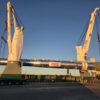The pontoon with the 4 mega cranes, 112 meters high, acquired by Grupo Davila for Termavi departed from Amsterdam – The company expects to disembark the vessel before Sunday.
The port’s new titan sails for home. The Super Post Panamax crane acquired by Grupo Davila in Holland for use in the Container Terminal -Termavi- left the docks of Amsterdam on Saturday. Throughout the week, the pontoon in which she travels with her three other twins – destined for the Tenerife terminal – will sail the waters of the North Sea and the Atlantic. The weather that accompanies her during this journey will mark her arrival in Vigo. The date that was handled yesterday is that the estuary will receive its new guest between Friday and Sunday. Rain, wind and bad sea conditions have already forced the postponement of the embarkation, originally scheduled for the end of September.
The move is a challenging one for the company and will mark a milestone in the industry. “This is the first time that four cranes of this type have been transported simultaneously on a pontoon,” says Álvaro Molina, head of the Projects Division of Altius, part of the Davila Group. To give an idea of the “complexity” of the process, Molina recalls that, between the four guindastes alone, the cargo totals more than 5,600 tons. “Up to the port of Brest, in France, we have a second tug for support; from then on we sail with only one tug,” he says. The speed at which it moves “depends on weather conditions”, but averages between 3.5 and 9 knots.
During the entire trip, Altius technicians will monitor the minute-by-minute progress of the cargo via the Internet. Its managers have a modern program that continuously updates the estimated time at which the pontoon will reach port. Nothing escapes in an unprecedented maneuver that will allow the unloading at Termavi of a 1,350-tonne, 112-meter-high (112 meters) boom – 72 meters in working position – and 26-meter-wide (26 meters) machine. These are measures that, in the entire Atlantic arc, can only be found in the Sines terminal in Portugal, making Vigo the best equipped port in Galicia. To tie the operation together, Altius used 320 tons of steel, 8,000 man-hours with a team of 20 welders and 750 engineering hours to design and build the reinforcements. Arriving in Vigo will not, however, be the end of the challenge. Back at Termavi, engineers will have to work with a counterweight system to prevent the weight on the platform from becoming unbalanced when the crane is lowered. “We’ll do it with ballast,” they advance.






